SuperSub - The Future of Sports
12 years ago, Kevin Kelly, WIRED editor, wrote a prescient essay predicting the rise of the creator economy. He asserted that creators can build sustainable revenue by deeply monetizing a small base of die-hard true fans.
Today, this creator economy is thriving in a lot of different verticals. Platforms and business-in-a-box startups have quickly enabled creators to monetize their passion. Through Twitch (gaming), Substack (Writing), Teachable (online courses), Patreon (everything else), and others, people are monetizing their biggest fans through subscription businesses.
I propose taking this concept and applying it to sports — an ecosystem that has left hundreds of millions of dollars on the table every year, by under-monetizing its biggest fans. Primarily operating in the offline world, sports teams and leagues have failed to capitalize on the shift to digital nativity to create unique experiences for their superfans.
Introducing: SuperSub Strategy
The SuperSub Strategy focuses on sports teams selling an exclusive annual digital subscription to their most hardcore “Super fans” giving them exclusive access, elevated status, and a private community to deepen their connection to the team and the personalities.
This SuperSub Strategy enables teams to:
- Build Deeper Relationships with Superfans, and make them feel special
- Monetize Hardcore Fans, wherever they are in the world
- Create Additional Revenue, with marginal costs
Sports 1.0
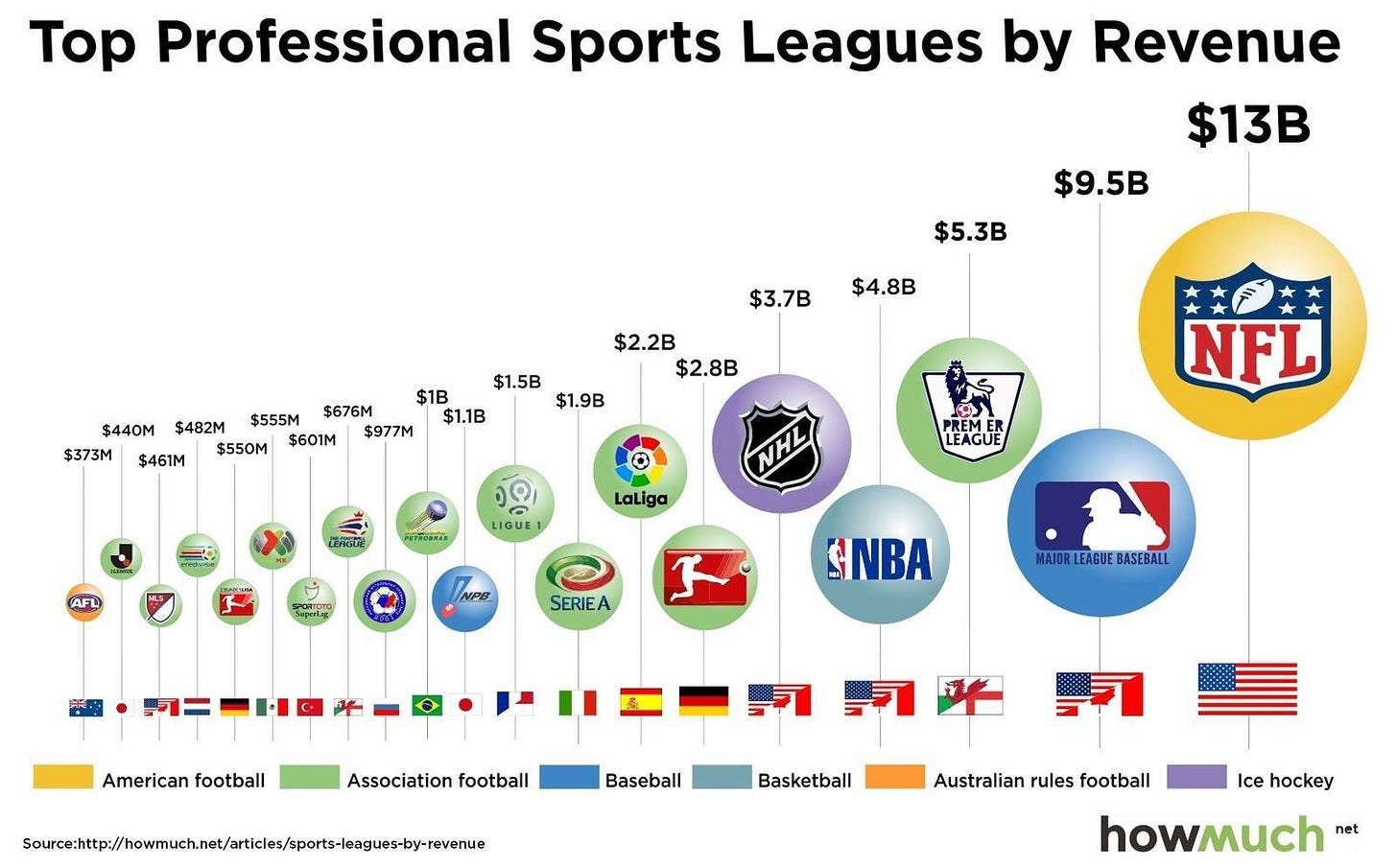
Let’s start by looking at how sports teams make money. Their revenue falls into two main buckets: national, and local.
National revenue has two major components - television rights deals and licensing and merchandising. TV rights are incredibly valuable. For example, the NBA is in the middle of a 9 year, $25B national TV deal with ESPN, ABC, & Turner. This revenue is split evenly among the teams and is the biggest share of annual revenue for the teams. On top of this, the league distributes proceeds from licensing the brand and likenesses for content and merchandise (3rd party merch = licensing revenue).
Ok cool. Teams are getting a chunk of their annual revenue top-down from the league. So what are teams doing to directly make money?
At the local level, teams are laser focused on ticket sales, concessions, and sponsorships. This is their bread and butter.
This model is less lucrative for challenger sports leagues like Major League Rugby, Premier Lacrosse League, World Surf League, and others. These leagues have small, highly energetic fan bases, but no big media rights deals.
For these leagues, revenue mainly comes from ticket sales and concessions, and value-in-kind sponsorships. In the absence of on-field rugby, their coffers dry up fast. Plus, they can’t afford to organize the season without fans since the cost of putting together a sporting event (even without fans) far exceeds their meagre media rights income.
Sports 2.0 - SuperSub
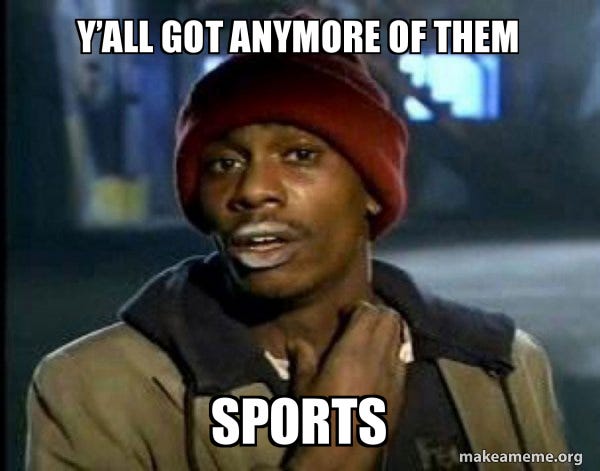
If I was running a sports team, I would focus on launching a SuperSub - an annual digital subscription for my team’s biggest fans, giving them the three things they want the most:
- Access
- Community
- Status
Access
Social Media has changed the fame game. In the past, celebrities were mysterious. They stepped on the pitch, did a fantastic job, and vanished into the night.
In 2020, fame is built on top of access. By giving unfettered access to their life, the Kardashians popularized the “Access Celebrity”. Nobody knows what they do, but everyone feels a deep sense of loyalty to the family having watched them grow up on the show. Despite being obscenely rich, access has made them relatable.
Sports are no different. Fans are desperate for more behind the scenes content. They want more intimate access to their favorite teams and personalities. Young athletes are taking advantage of this to build a brand and a following.
Javale McGee (Love the guy, but Career PPG: 7.9) and Matisse Thybulle (Career PPG: 4) have been vlogging their journey in the NBA bubble and their videos are averaging over a million views each. Lonzo Ball has similarly built a rabid following, despite his poor on-court performances, through his own reality show — Ball in the Family, which had 3.4M views per episode. I am a Lonzo stan and proud of it.
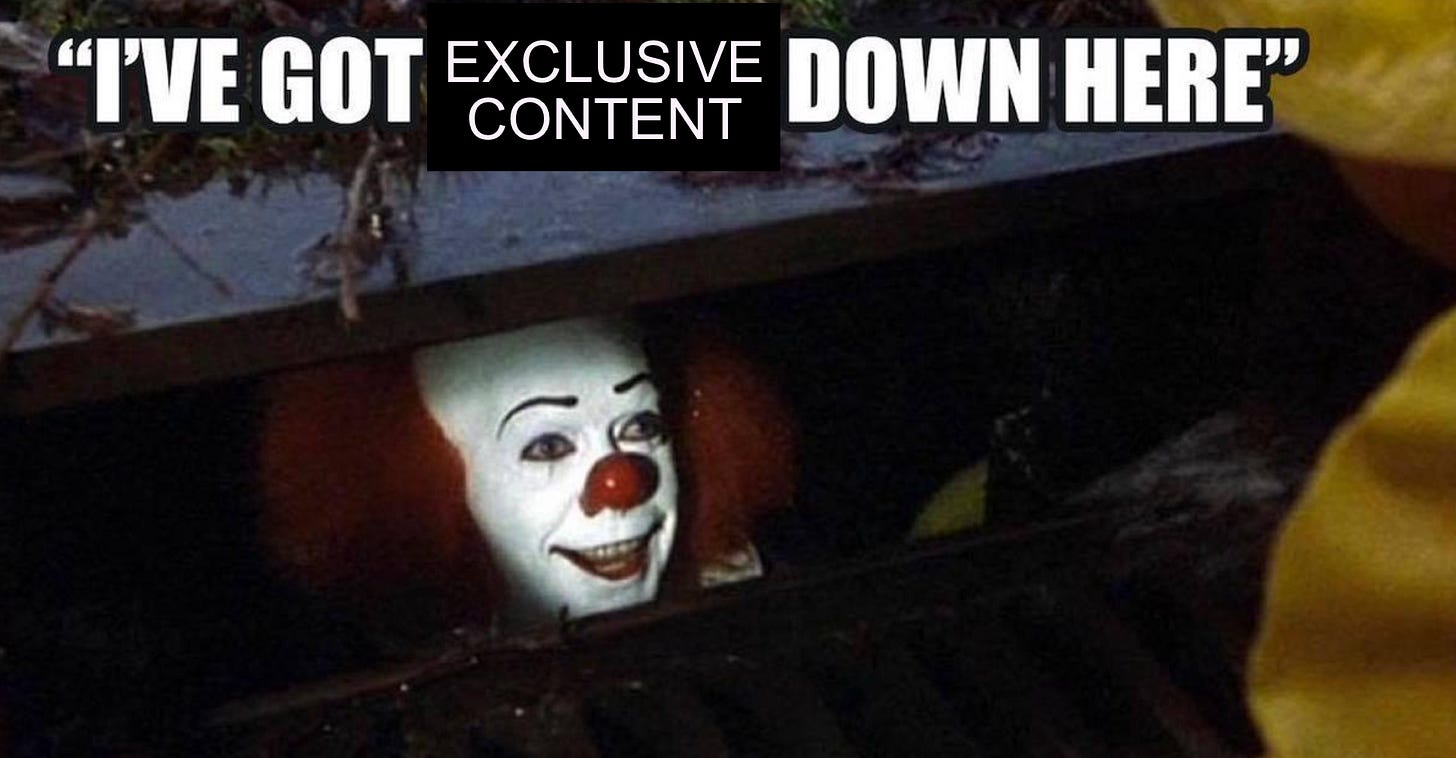
Access is the first key component of the SuperSub strategy. Turn your players, coaches, and executives into media companies and create high quality content and give your SuperSubs exclusive access. Your most die-hard fans would love to listen in to a locker room conversation between Brady and Gronk, be a fly on the wall for Lebron’s Taco Tuesdays, or even spend thousands for virtual meet and greets and to attend virtual scrimmages.
Shameless plug, I helped the CEO of the New England Free Jacks launch his own ‘behind the scenes’ podcast with a similar goal.

jason@calacanis.com @Jasonthe @NBA should sell the virtual seats and give folks a virtual meet and greet with the teams before and after, let them into the huddle and let them ask questions at the press conference. They could sell those seats for $1,000 each with that package! #NBARestartonTNT11:12 PM ∙ Jul 30, 2020
117Likes8Retweets
Deliberately not talking too much about VR here, but just imagine in-game access through VR…
Community
Being a sports fan is all about community and shared identity. Walking past someone in a Lakers jersey, feels like being part of an in-group. Sports fans are seeking out these communities online and spending a lot of time in them. The /r/nba subreddit has 3.4 million NBA fans, while 245,000 people lurk in the /r/lakers subreddit. These are fans looking for a shared digital space to talk basketball with their tribe. Teams are currently completely missing out on this massive source of digital engagement from their hardcore fans. How hardcore? A fan put together this in depth, hilarious, analysis of the impact of Taco Tuesdays on Lebron’s stats. The result? 20k+ upvotes, 50 awards (aka $$$ for reddit), and 2000+ comments. The Lakers missed out.
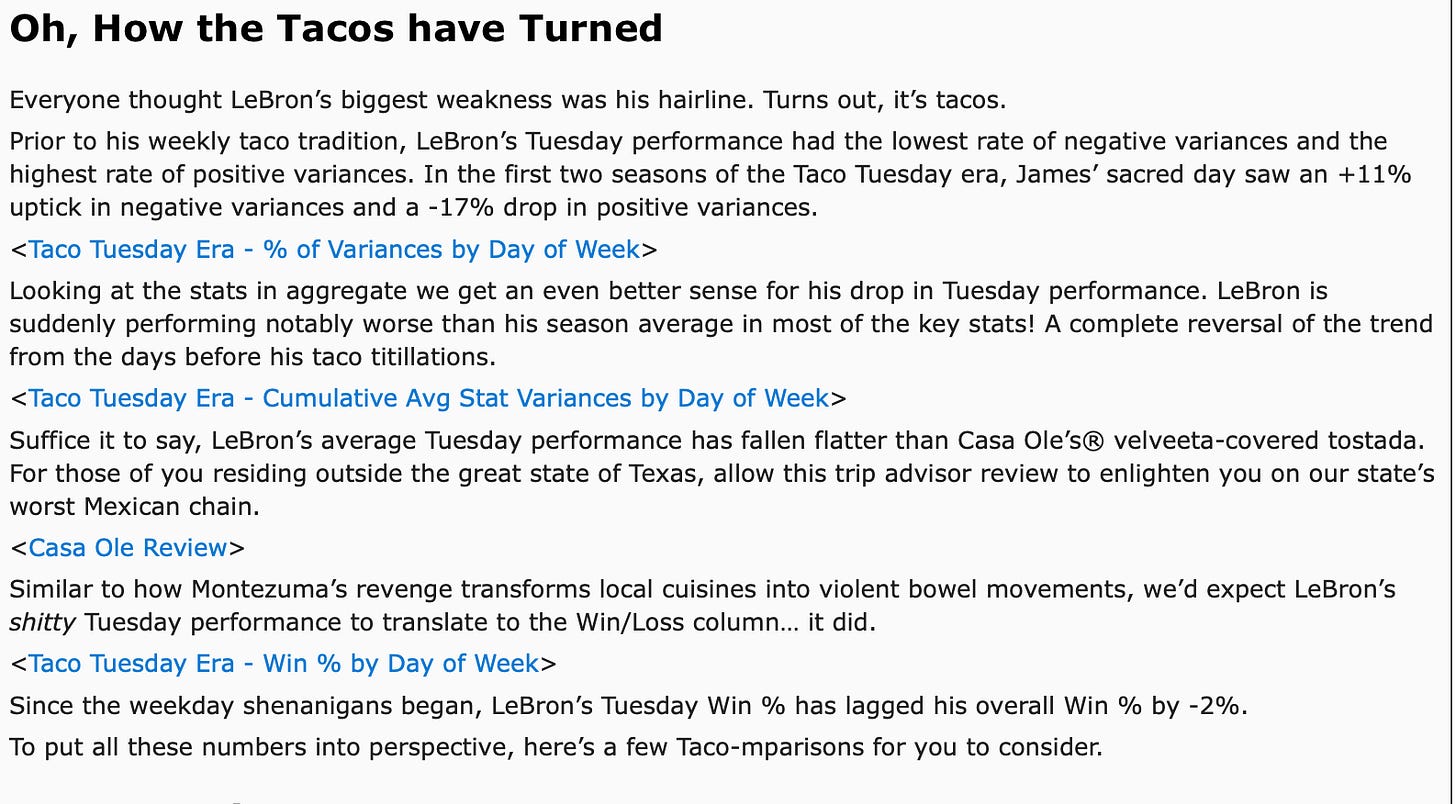
Community is the second pillar of the SuperSub strategy. Create, manage, and monetize your own third space for your most hardcore fans to hangout with each other. Make it exclusive, so your fans wear membership like a badge of honor, further enticing other fans to be more hardcore, because they want to be a part of this in-group.
Status
“People are status seeking monkeys”
Eugene Wei, Status-as-a-Service
Humans are always playing status games. Owning a clubhouse account before everyone else is a status game. Being verified on Twitter? Status game. Knowing a celebrity (saw them on the street once)…status game.
Sports fans are no different. They want the status of being a supporter of the best team. That’s why everyone hates bandwagon fans because they are newer fans and hence have a lower status. The entire premise of March Madness is a status game — showing off my superior knowledge of random college basketball teams.
Sports teams have done good job monetizing these status games in the offline world — selling court-side seats and box seats.
The final piece of an effective SuperSub strategy is Status. Give your super-fans a pathway to an elevated status. Find ways to highlight their status and make them feel better and more special than everyone else. And this status isn’t only dependent on money, but also on activity and participation. Showcase your most active fans and community leaders, and give them bragging rights through physical and digital activations.

SuperSub in Action
Let’s run some scenarios to see the potential scale of the SuperSub strategy in two distinct cases: a top sporting brand with a massive existing audience, and a challenger brand building an audience from the ground up.
Los Angeles Lakers
The LA Lakers have 14M instagram followers and 22M fans on FB. Conservatively, if there are 10M Lakers fans in the US, then 0.5% of them are die-hard superfans.
The Lakers launch the “Kobe Program”, a digital subscription program for superfans to get exclusive content (podcasts, vlogs, videos, subs-only zoom calls with team), a member-only digital community app, and a special Kobe metal membership card which gets them exclusive deals with brand partners. Let’s say they launch with tiered rewards.
- Rookie ($200/yr) (92% of superfans choose this option)
- All Star ($400/yr) (7.5% of superfans pick this option)
- Hall of Fame ($1000/yr) (0.5% of superfans pick this option)
Here’s what Lakers’ SuperSub revenue would look like -
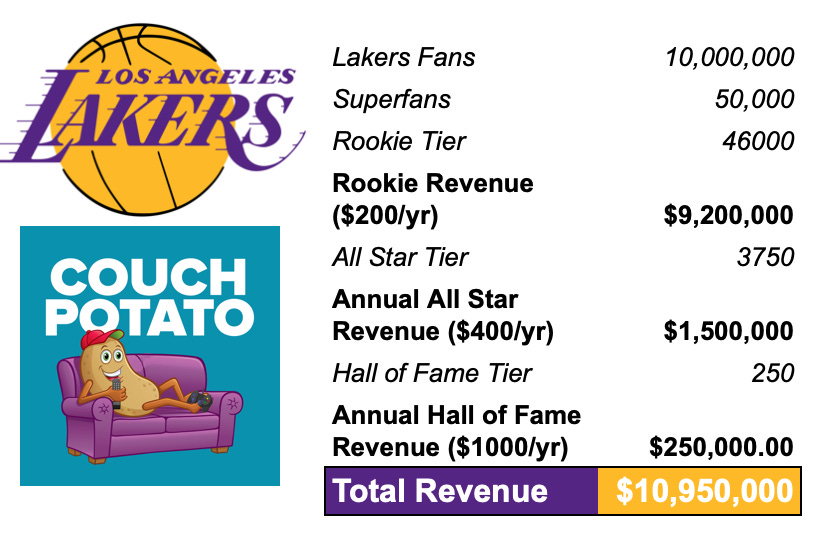
This adds $11M in revenue with minimal marginal costs. More importantly, it deepens the connection between the Lakers and its superfans and gives the organization more access to ancillary content and monetization opportunities. Plus, it allows the team to monetize fans like me, who they otherwise couldn’t monetize — hardcore fans who can’t attend Lakers games because they don’t live in LA.
There are also second order positive externalities. At a high level, the Lakers can further monetize this die-hard community with sponsors and brand partners, communicate more directly and intimately with fans and get access to their UGC and feedback, and convert them into ticket holders and merchandise buyers at a higher rate. Plus, these perks will entice other fans (who consider themselves superfans) to be more involved (and spend more money) to get access to the Kobe Program.
Couch Potato FC
Now let’s see a similar implementation at a smaller, challenger sports team, playing in a startup league.
Let’s say Couch Potato FC only has 20,000 fans. Since its in a smaller league, building a brand from the ground up, a bigger proportion of their early supporters would consider themselves superfans. Let’s consider 5% for this example, and a single tier of membership for $300/yr.

An extra 300k is a massive increase in revenue for a startup sports league without a media rights deal. Add a decrease in ticket sales due to COVID, and this might easily be the largest revenue driver for 2020.
If the number seems small, here is some additional context. The NBA has a $25B media rights deal split by 30 teams. Essentially, the Lakers’ cut of this deal is equivalent to $9.26 per Lakers fan.
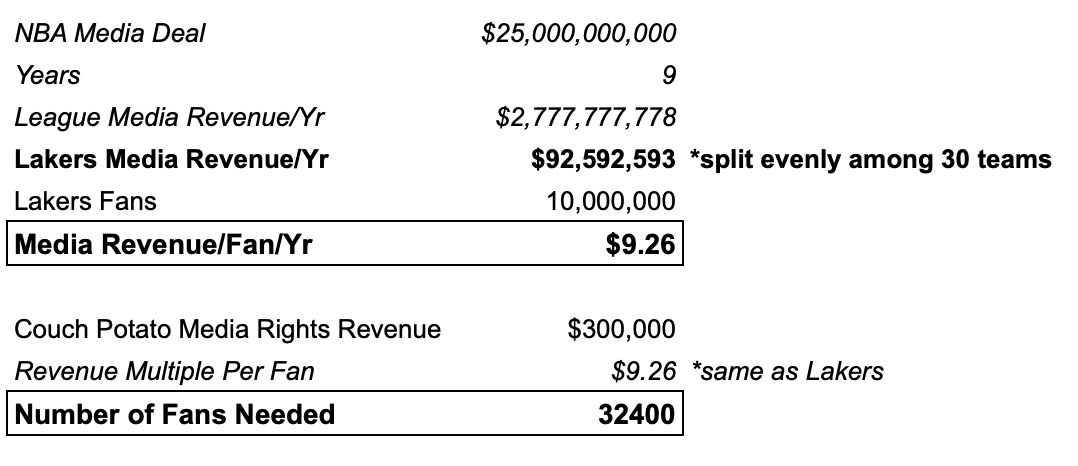
Couch Potato needs 32,400 fans to generate $300k in media rights revenue, which they can otherwise get using the SuperSub strategy with only 1000 super fans. That is, assuming my league can even get a meaningful media rights deal at such a small scale.
This SuperSub Strategy is going to grow in importance over time as sports increase their focus on the digital fan experience for their hardcore superfans. Plus, it allows teams to monetize their die-hard fans, who otherwise aren’t close enough to buy tickets and attend games.
By combining Access, Community, and Status to create a brand new digital fan experience, sports teams and leagues would unlock alternate revenue streams and ways to build a deeper connection between the fans the team and its personalities.
I would love to hear your feedback, thoughts, and questions! Just hit reply or put it in the comments below!